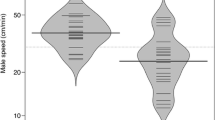Summary
The breeding system of the dung fly Sepsis cynipsea has a precopulatory guarding phase during which a male prevents other males from gaining access to a female while she lays her eggs in the dung. After oviposition, the pair leaves the dropping and may copulate. Large males have three advantages over smaller males in mating success; they are more likely to become paired (Table 1), they copulate with larger females (Fig. 4) and they are more successful in fights between males for the possession of females.
Pairs are formed at random with respect to the sizes of the male and female in the pair but at copulation there is positive assortative mating (Fig. 4). The mechanism for this change is unknown.
Small males modified their mate searching behaviour to attempt to improve their chances of finding a female. They searched more on the dung surface than in the grass and for longer round any one dropping (Fig. 5) than did larger males.
The mean adult size in both sexes declined over the season (Table 1, Fig. 3). It is suggested that most of the size variation present is due to environmental causes. This has led to phenotype limited mate searching; a male's searching behaviour is closely related to his size.
Guarding is probably precopulatory rather than postcopulatory as in the dung fly Scatophaga stercoraria, which breeds in the same droppings, because males are much smaller than females and so cannot force copulation on unwilling females.
Similar content being viewed by others
References
Atkinson WD (1979) A field investigation of larval competiton in domestic Drosophila. J Anim Ecol 48:91–102
Borgia G (1981) Sexual competition in Scatophaga stercoraria: female choice in a male-controlled system. Anim Behav 29:71–80
Davies NB, Halliday TR (1977) Optimal mate selection in the toad Bufo bufo. Nature 269:56–58
Hammer O (1941) Biological and ecological investigations in flies associated with pasturing cattle and their excrement. Bianco Lunos Bogtrykkeri, Copenhagen
Maynard Smith J, Price GR (1973) The logic of animal conflict. Nature 246:15–18
Parker GA (1970) The reproductive behaviour and nature of sexual selection in Scatophaga stercoraria L. (Diptera: Scatophagidae). VI. The origin and evolution of the passive phase. Evolution 24:791–805
Parker GA (1972a) Reproductive behaviour of Sepsis cynipsea (L.) (Diptera: Sepsidae). I. A preliminary analysis of the reproductive strategy and its associated behaviour patterns. Behaviour 41:172–206
Parker GA (1972b) Reproductive behaviour of Sepsis cynipsea (L.) (Diptera: Sepsidae). II. The significance of the precopulatory passive phase and emigration. Behaviour 41:242–250
Parker GA (1974) Assessment strategy and the evolotion of fighting behaviour. J Theor Biol 47:223–243
Parker GA (1978) Searching for mates. In: Krebs JR, Davies NB (eds) Behavioural ecology. Blackwell, Oxford
Parker GA (1982) Phenotype-limited evolutionarily stable strategies. In: King's College Sociobiology Group (eds) Current problems in sociobiology. Blackwell, Oxford
Partridge L, Farquhar M (in press) Lifetime mating success of male fruitflies (Drosophila melanogaster) is related to their size. Anim Behav
Ridley M, Thompson DJ (1979) Size and mating in Asellus aquaticus (Crustacea: Isopoda). Z Tierpsychol 51:380–397
Pont AC (1979) Sepsidae. Diptera, Cyclorrapha, Acalyptrata. R Entomol Soc (Lond) Vol X, Part 5 (c)
Sigurjonsdottir H (1980) Evolutionary aspects of sexual dimorphism in size: Studies on dungflies and three groups of birds. PhD thesis, University of Liverpool
Author information
Authors and Affiliations
Rights and permissions
About this article
Cite this article
Ward, P.I. The effects of size on the mating behaviour of the dung fly Sepsis cynipsea . Behav Ecol Sociobiol 13, 75–80 (1983). https://doi.org/10.1007/BF00295078
Received:
Accepted:
Issue Date:
DOI: https://doi.org/10.1007/BF00295078




